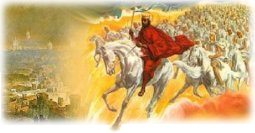Edward Irving (1792-1834) 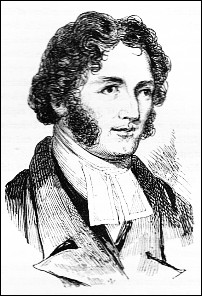 is undoubtedly my favorite reformer from history. Some may question calling him a reformer, but that is exactly what he was. He participated in the worldwide Second Advent revival in the early 1800’s. His field of ministry was England and Scotland (his birth-place).
is undoubtedly my favorite reformer from history. Some may question calling him a reformer, but that is exactly what he was. He participated in the worldwide Second Advent revival in the early 1800’s. His field of ministry was England and Scotland (his birth-place).
Irving ministered just before William Miller began his ministry: Irving died in 1834; Miller started his ministry in 1832. Therefore, like Miller, he was not aware of the Sabbath truth, the state of the dead, the sanctuary, and a few other truths that came in either later in the Millerite movement, or after the great disappointment.
His two volumes on the book of Revelation, “Exposition of the Book of Revelation in a Series of Lectures,” originally written in 1831, contain by far the most spiritual comments and explanations of this important book of the Bible, above and beyond any other author before him, and are still well beyond what is taught in most churches today regarding prophecy and how it fits in with the gospel plan. I have prepared these writings on Revelation and they are posted below.
Asides from his involvement in the Advent revival, he was a remarkable man in many ways. He combined a deep learning and eloquence, with a sensitive and warm Christian love, especially for the poor, whom he often ministered to when he was training in Scotland. He expected God to do wonderful things through the church before Christ’s appearing, but would not live to see that day, as his life was cut short at a fairly young age (42).
Some recent authors have attempted to paint Edward Irving as one of the founders of the modern-day “Pentecostal” movement, but I believe this is not a fair view of him. It is true that he expected spiritual gifts to come again in the church, in fulfillment of the prophecies of the “latter rain”. The “former rain” was the outpouring of the Holy Spirit on the early church, which brought in supernatural gifts. He expected the same in the “latter rain” which would be a special endowment of the Holy Spirit’s power before God’s work would close in the earth. This is also a common expectation in the Adventist churches.
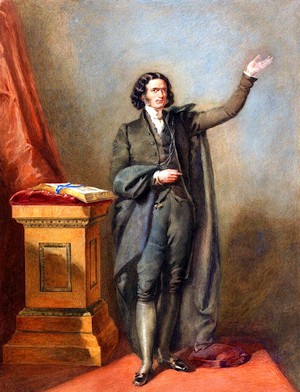 As a result of his preaching this doctrine, some members of his congregation and elsewhere began to manifest some gifts: dreams, prophesying, and tongues. But Irving, although he felt bound to accept some of these manifestations as genuine (and some of them certainly may have been), himself did not participate in this. Those who only look at this aspect of his life, tend to overlook the rich teachings on prophecy and the outworking of God’s plans through Christ in history, which he loved to dwell on, and which constitute a large part of the treasure he has left behind.
As a result of his preaching this doctrine, some members of his congregation and elsewhere began to manifest some gifts: dreams, prophesying, and tongues. But Irving, although he felt bound to accept some of these manifestations as genuine (and some of them certainly may have been), himself did not participate in this. Those who only look at this aspect of his life, tend to overlook the rich teachings on prophecy and the outworking of God’s plans through Christ in history, which he loved to dwell on, and which constitute a large part of the treasure he has left behind.
Irving took part in the Advent revival, and therefore was an Adventist: one who not only expects Christ to come very soon, but prepares diligently for that event, and cooperates with the Lord in bringing it to pass. Irving lamented (in his comments on the Laodicean church) that the Protestants of his day had largely turned the atonement into a kind of “indulgence” to cover all sins, and to excuse the need for a fervent striving after holiness of heart and life, and a separation from all things worldly. Modern Protestantism has not changed for the better, and modern Pentecostalism continues to promulgate this same false gospel. Therefore, Irving was by no means a forerunner of the modern Pentecostal movement.
Other distinctive Adventist features of his message were:
- He emphasized the need of the church to be ready for Christ, to strive for perfection and holiness, and to overcome all sin through the power of Christ.
- He mentioned the 1844 date as the “most likely” time of Christ’s return, in one of the volumes on Revelation.
- He understood and taught that the papacy was Antichrist, and that the worldly churches would join with her if they did not repent.
- He emphasized the Revelation 14 (first angel’s) message that “the hour of His judgment is come.”
- He taught that the message to Sardis was to the historic Protestant churches, the message to Laodicea was especially to the world-loving Christians of his time, and the message to Philadelphia was to the few who were grasping the Advent message and living it.
- He participated in some Prophetic Conferences with a few other ministers and laymen of his day who were also looking for God’s light for their day, in the prophetic word.
- He translated into English, Lacunza’s book on Christ’s Coming (see The Great Controversy, p. 363).
- He foretold that God would raise one up from the “clods of the earth” (William Miller was a farmer), who would give forth God’s message for this time.
He treated the book of Revelation as it was intended to be: an open door into the knowledge of God’s plan through Christ to restore what sin had taken away. Someone wisely once said that “in the Revelation all the books of the Bible meet and end.” (Ellen White, Acts of the Apostles, p. 585). He loved to trace these threads, pulling in analogies, prophecies, types, patterns, and parallels all through the Bible to show how God’s great plan had been unfolding, step by step. Of this work, he wrote:
…there arose in my mind a strong conviction that the thing which the Church needed was not so much another exposition, added to the multitude which she already possessed, of this blessed book, as a practical exhibition of the infinite theological and moral treasures which it contains; not so much another scheme of interpretation, or the scheme of former interpreters corrected by the new lights which have been cast upon the subject, as a demonstration of the excellence of the materials whereof it is composed, and their fitness for the edification of all saints.
For it is beyond question, that the great body both of Christian ministers and of Christian people, are deterred from studying and perusing this book by nothing more than a false notion that it is mysterious and cabalistical, and only for the edification of those who are learned. (Preface to Book 1)
Irving also taught strongly that Christ had the same fallen sinful flesh as us, with all it’s tendencies to sin, and that Christ’s victory over the flesh was an assurance that we could have the same victory. The Presbyterian church in Scotland eventually charged him with “heresy” for teaching this. But it was not heresy! It was beautiful truth, which many were not able to grasp, and so instead they mistook it for something dangerous (and many still make that mistake today).
In the late 1800’s, this important truth about Christ’s humanity was revived in the teachings of two young Seventh-day Adventists: E. J. Waggoner and A. T. Jones, and later became part of what was known as “the 1888 message.” It is a foundational teaching in the church I belong to, which has its roots in that Adventist revival of 1888.
But Irving clearly expounded on the beauty of that truth over 50 years previous to 1888. He even devoted a whole book to the topic of the Incarnation of Christ. The importance of Christ’s identification with humanity is seen in the promise given to Laodicea, the last church of the seven in the book of Revelation:
Revelation 3
21 To him that overcomes…even as I also overcame…
Christ overcame, so we can too. This would not be possible if He did not resist the sins that we face through our flesh. The assurance of our victory over sin is that He already went through the battle and won, and now He gives us a life that is able to meet the same temptations in our flesh. He connected His divinity with our humanity in His own flesh, so that sin could be defeated. Now He promises to connect His divinity with our humanity, so that sin can be likewise defeated again.
Irving grasped this truth and saw it’s important connection with the last day events, and the preparation for Christ’s return, and so taught it with all zeal and earnestness, even though it cost him his position with the Scottish Presbytery. Irving was ahead of his time, and this is only one example.
Whereas the Advent message is a dividing message, because it seeks for a clearer understanding of Christ, the Word of God, and because it calls people to come out from false spirits and practices in preparation for the Lord’s coming, Pentecostalism is a movement that unites the fallen churches and brings them back to union with Rome: distinctions in doctrine are minimized, and miracles and ecstatic experiences are put in their place, as signs of spiritual blessing and authority. The Advent message does not ignore spiritual gifts, but puts them in their proper place: as a means whereby the truths of the gospel can reach more people, and whereby church union and order can be perfected. Irving clearly identified with the Advent message, and the truths he taught led to separation from error, and not union with it.
I should perhaps also mention that the British Adventists differed from their American counterparts in their interpretation of prophecy as relating to the literal Jews. The British Adventists tended to the view that the literal Jews (those physically descended from Abraham) would return to the land of Palestine and be restored as God’s chosen people again. The American Adventists believed the fulfillment of the prophecies relating to the Jews would be fulfilled to believers, those making up Christ’s body,–the church.
Irving shared the view of the British Adventists, and so you will find him sometimes expounding this idea. However, it is not the main point of his lectures, and should not cause too much distraction from the rich treasures that he unfolds throughout these expositions on this precious book of Revelation.
The Revelation of Jesus Christ (1831)
Book 1 – Name, Authority, Substance, and Sanctions of the Book
Book 2 – Christ Revealed by Names
Book 3 – Christ the Universal Head and Bishop of the Church
Book 4 – Epistle to the Church in Ephesus
Book 5 – Epistle to the Church in Smyrna
Book 6 – Epistle to the Church in Pergamos
Book 7 – Epistle to the Church in Thyatira
Book 8 – Epistle to the Church in Sardis
Book 9 – Epistle to the Church in Philadelphia
Book 10 – Epistle to the Church in Laodicea
Book 11 – The Vision of Heaven
Book 12 – The Worship in Heaven
Book 13 – The Lamb Slain
Book 14 – Opening of the First Four Seals
Book 15 – Opening of the Fifth Seal
For Missionaries After the Apostolical School (1824)
1. Name, Authority, Substance, and Sanctions of the Book
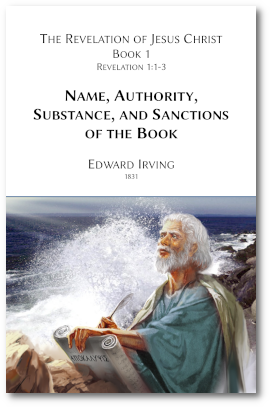 This first volume deals with the first three verses of chapter 1 in the book of Revelation, as well as taking an overview of the whole book, and how it was transmitted, and the warnings and promises concerning it. 140p
This first volume deals with the first three verses of chapter 1 in the book of Revelation, as well as taking an overview of the whole book, and how it was transmitted, and the warnings and promises concerning it. 140p
Contents
- The Proposal
- The Name of the Book
- The Authority of the Book
- Its Origin from God
- Its End
- The Transmission of It
- The Seer Through Whom It Comes to Us
- The Substance and Method of the Book
- Christ the Universal Bishop
- Christ the Redeemer and Heir
- Christ the Intercessor and Avenger
- Christ Gathering His Church
- Christ Triumphing and Reigning
- The Sanctions of the Book
- The Sanction of Blessing
- The Sanction of Knowledge
- The Sanction of Fear
- Conclusion
2. Christ Revealed by Names
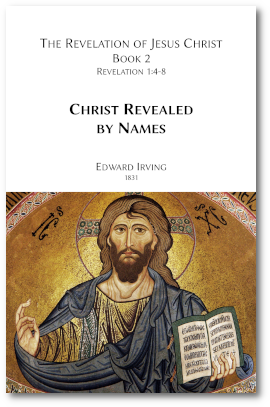 This second volume deals with verses 4 to 8 of chapter 1 in the book of Revelation, dwelling in particular on the various names by which Christ is revealed, and their spiritual meaning. 124p
This second volume deals with verses 4 to 8 of chapter 1 in the book of Revelation, dwelling in particular on the various names by which Christ is revealed, and their spiritual meaning. 124p
Contents
- Introduction
- The Prelude, or Overture
- The Number Seven
- The Benediction
- Grace
- Peace
- The Name of the Father
- The Godhead
- The Name of the Holy Ghost
- The Seven Spirits
- Before His Throne
- Name of the Son
- Jesus
- Christ
- The Faithful Witness
- First Begotten
- Prince
- Summary
- Doxology
- Unto Him That Loved Us
- Washed Us From Our Sins
- Kings and Priests to God
- The God and Father of Jesus Christ
- Glory and Strength
- Second Advent
- Names of Christ
- Alpha and Omega
- Beginning and Ending
- Which Is, Which Was, Which Is To Come
- The Almighty
- Conclusions
3. Christ the Universal Head and Bishop of the Church
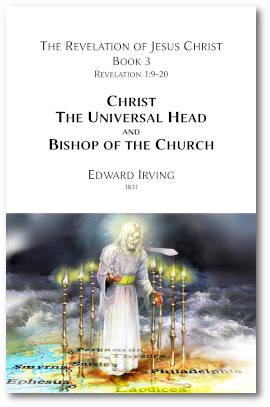 This third volume deals with verses 9 to 20 of chapter 1 in the book of Revelation.
This third volume deals with verses 9 to 20 of chapter 1 in the book of Revelation.
It is divided into two parts: the first part deals with the vision of Christ which John saw, expounding each detail; the second part is an introduction to the messages to the seven churches, concentrating on the relationship between Christ the Head, the “angel” (or, messenger), and the candlestick (or, church). 161p
Contents
- The Vision
- The Place and Condition
- The Time
- In the Spirit
- A Great Voice
- A Book for All Churches
- A Complete Revelation of Christ
- Christ Ruling Among His Church
- The Seven Candlesticks
- The Son of Man
- The Garment
- His Head
- His Eyes and Feet
- His Voice
- The Seven Stars
- The Sharp Sword
- His Countenance
- The Announcement: “Fear not”
- The Announcement: “I am the First and the Last”
- The Announcement: “I am the Living One”
- His Seven Epistles
- The Seven Stars
- The Seven Golden Candlesticks
- In the World
- The Seven Epistles
4. Epistle to the Church in Ephesus
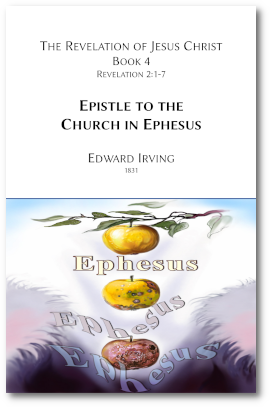 The Church in Ephesus is the first of the Seven Churches of Revelation.
The Church in Ephesus is the first of the Seven Churches of Revelation.
The messages to the churches are divided into three parts:
- The name or description of Christ by which He introduces Himself to the church;
- The charge to the angel of the church, consisting of positive and negative observations;
- The Spirit’s exhortation and promise to the overcomers in the church.
The Ephesus Church is a symbol, historically for the apostolic church, and experientially, for the first love of a believer to Christ. Losing the first love is the cause of every other departure from God. 116p
Contents
- Introduction
- Christ’s First Designation
- Likened to Stars
- Relation to the Candlestick
- In the Right Hand
- Walking in the Midst of the Candlesticks
- His First Charge
- Testing Apostles
- Bearing and Laboring with Patience
- Leaving the First Love
- The Deeds of the Nicolaitanes
- The Spirit’s First Exhortation
- The Spirit Speaking to the Churches
- Placement of the Exhortation
- An Ear to Hear
- His First Promise
- The Tree of Life
- The Paradise of God
- To Eat of the Tree
- Him that Overcomes
- Conclusion
5. Epistle to the Church in Smyrna
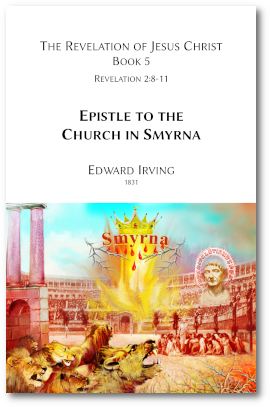 The Church in Smyrna is the second of the Seven Churches of Revelation.
The Church in Smyrna is the second of the Seven Churches of Revelation.
The Church in Smyrna represented the persecuted church, and Jesus revealed Himself to her as the “one who was dead and is alive”, who knew of their tribulation, poverty, and sufferings. He promised them a crown of life, and that they would “not be hurt of the second death”, which meant that they would come up in the first resurrection. 123p
Contents
- The Importance of Spiritual Interpretation
- Historical Background
- Christ’s Second Designation
- The First and the Last
- Which was Dead and is Alive
- The Love of God
- The Law of God
- Christ’s Unity with Human Nature
- Moral Higher Than Physical
- Lessons from His Resurrection
- His Second Charge
- I Know Your Works
- I Know Your Tribulation
- I Know Your Poverty
- False Jews
- A Crown of Life
- Tribulation Ten Days
- The Unchangeable Love of God
- Christ: The Prince of Suffering
- The Faith of Jesus
- The Devil: The Instigator of Persecution
- Warning Against the Persecutors
- Persecution as Chastisement
- The Spirit’s Second Promise
- Promise of the Resurrection
- Isaiah 25 and 26
- Nature of the Second Death
- Conclusion
6. Epistle to the Church in Pergamos
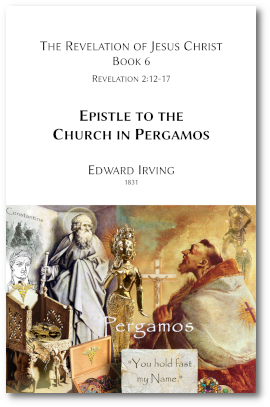 The Church in Pergamos is the third of the Seven Churches of Revelation.
The Church in Pergamos is the third of the Seven Churches of Revelation.
The Church in Pergamos represented the church entering into worldy favor and prosperity, a deadly snare which, if unrepented of, would lead to full-blown apostasy and the development of a false Christian system that courted worldy power and influence instead of the power of God through His word. 124p
Contents
- Introduction
- The Constitution of the Church
- Christ Works Through His Church
- A Key to the Rest of the Book
- Prophetic History
- Christ’s Third Designation
- Of Discipline
- Satan’s Seat
- Holding Fast Christ’s Name And Faith
- Antipas, the Faithful Martyr
- The Reproof
- The Balaamites
- The Nicolaitanes
- The Threatening
- The Spirit’s Promise
- The Hidden Manna
- The White Stone
7. Epistle to the Church in Thyatira
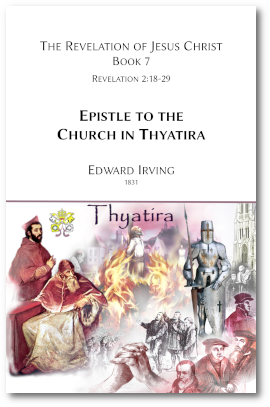 The Church in Thyatira is the fourth of the Seven Churches of Revelation. The Church in Thyatira represented a church living during the time of apostasy, when true religion was rare and false religion abounded.
The Church in Thyatira is the fourth of the Seven Churches of Revelation. The Church in Thyatira represented a church living during the time of apostasy, when true religion was rare and false religion abounded.
Historically, it especially points to the time of Papal supremacy in Europe, the time of the Dark Ages, and leading into the time of the Protestant Reformation. The true church was hidden away “in the wilderness”, while “Jezebel, the false prophetess” was propped up as the church. However, the counsels and warnings to this church apply to any age or believers who find themselves in a similar situation.
This book is the second-longest of Irving’s lectures on the churches, partly due to the inclusion of a 100 page dissertation on what it is that the church is to “hold fast” till Christ comes. He makes it clear that the things to hold fast are not just the gospel teachings, but the spiritual gifts, which Christ originally gave to the apostolic church and were to continue to the end. 269p
Contents
- Introduction
- The Style of the Chief Shepherd
- Son of God
- Eyes Like a Flame of Fire
- Thyatira and Jezebel
- The Commendation
- Works
- Love
- Service
- Faith
- Patience
- Works Again
- The Rebuke to the Angel
- No Excuse for Imperfection
- That Woman Jezebel
- Space to Repent
- Her End
- Those That Are Left
- Those Who Have Not This Doctrine
- The Depths of Satan
- No Other Burden
- Hold Fast
- Till I Come
- What the Church is to Hold Fast till Christ Come
- The Church is the Body of Christ
- What Power Has Christ Received?
- How Much Power is Revealed?
- A Firstfruit, or Earnest
- Power Over Five Areas of Creation
- Not Merely an Evidence of God’s Power
- Organization of the Church
- The Gifts
- Are the Gifts Withdrawn?
- Our Present State
- The Promise
- False Works
- Keeping Christ’s Works Unto the End
- Power Over the Nations
- The Morning Star
- Conclusion
8. Epistle to the Church in Sardis
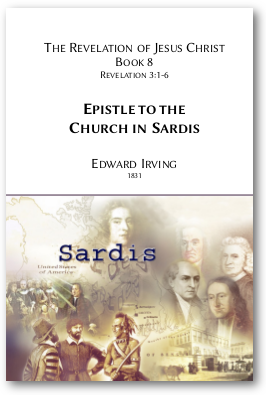 The Church in Sardis is the fifth of the Seven Churches of Revelation. The Church in Sardis represented a church living after a time of revival, when the people were becoming content with their name and reputation, and were no longer advancing in truth and life.
The Church in Sardis is the fifth of the Seven Churches of Revelation. The Church in Sardis represented a church living after a time of revival, when the people were becoming content with their name and reputation, and were no longer advancing in truth and life.
Historically, it especially points to the time after the Protestant Reformation, and the various revivals that kept the Protestant bodies spiritually alive, had passed. Irving especially felt that the messages spoken to Sardis applied to the churches of his day.
Christ offered this church a good name before God and an unspotted robe because they were settling for a name and character that was spoken well of, among men. In short, the churches were seeking human praise and approval, and a humanly-approved standard of character, instead of the honor that comes from God alone. 227p
Contents
- Introduction
- The Style of the Chief Shepherd
- The Glory of a Name
- The Voice of the Majority
- Witnesses of the Lord’s Coming
- Historical Background
- Our High Priest’s Style or Designation
- The Seven Spirits
- The Seven Stars
- The Instructions to the Angel of the Church
- A Good Name
- Watchfulness
- Strengthening What Remains
- The Standard of Perfection
- Remember How You Received
- Hold Fast and Repent
- The Threatening
- What It Means to Watch
- The Time of Accountability
- The Results of Not Watching
- As a Thief
- The Results of Watching
- The Nature of the Evil
- The Approbation
- A Worthy Name
- Pure Garments
- The Meaning of Garments
- The Spirit’s Exhortation and Promise
- The Voice of Popular Opinion
- Pertaining to Church Order
- The White Raiment
- The Book of Life
- Conclusion
- Sonnets
9. Epistle to the Church in Philadelphia
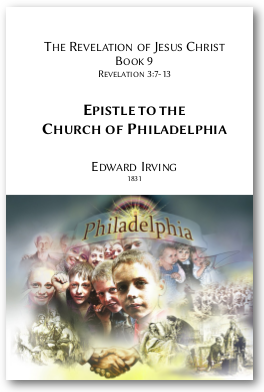 The Church in Philadelphia is the sixth of the Seven Churches of Revelation. The Church in Philadelphia represents the small group of faithful believers who came out of the formality of the Sardis church period, and were awake to the soon coming of their Lord.
The Church in Philadelphia is the sixth of the Seven Churches of Revelation. The Church in Philadelphia represents the small group of faithful believers who came out of the formality of the Sardis church period, and were awake to the soon coming of their Lord.
Christ revealed Himself as Holy and True, because not numbers nor money, but holiness and truth were the strength of the little Philadelphian band.
The early Advent believers of the 1800’s, especially those like Edward Irving himself, identified strongly with the Philadelphian message and experience. Christ had set before them an “open door” into the precious truths pointing to his near Advent and the prophetic events that would take place before Christ’s return. New duties were opened to the church, and a much greater concept of what it would mean to stand alive (to be “kept from the hour of temptation”) on the earth when the Son of God and Man would return as King of kings, and Lord of lords.
The precious promises to the Philadelphian church also pointed to the last work of the church upon earth: playing a special role in the work of redemption, of being “pillars” in the temple (also called the “firstfruits” in Revelation 14), of having the “Father’s name” (character) specially developed within them (mentioned in Revelation 7 and 14).
The Philadelphian church is also one of the few that has no words of condemnation against it. All who love holiness and truth will find this study most profitable. 205p
Contents
- Introduction
- The Style of the Chief Shepherd
- The Glory of a Name
- The Voice of the Majority
- Witnesses of the Lord’s Coming
- Historical Background
- Our High Priest’s Style or Designation
- The Seven Spirits
- The Seven Stars
- The Instructions to the Angel of the Church
- A Good Name
- Watchfulness
- Strengthening What Remains
- The Standard of Perfection
- Remember How You Received
- Hold Fast and Repent
- The Threatening
- What It Means to Watch
- The Time of Accountability
- The Results of Not Watching
- As a Thief
- The Results of Watching
- The Nature of the Evil
- The Approbation
- A Worthy Name
- Pure Garments
- The Meaning of Garments
- The Spirit’s Exhortation and Promise
- The Voice of Popular Opinion
- Pertaining to Church Order
- The White Raiment
- The Book of Life
- Conclusion
- Sonnets
10. Epistle to the Church in Laodicea
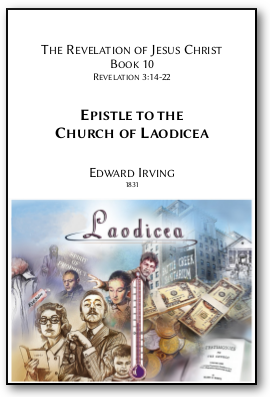 The Church in Laodicea is the seventh, and last, of the Seven Churches of Revelation. The Church in Laodicea represents the condition of the final phase of the church in the history of the world. It presents to our view a sad decay away from the heights of faith and experience achieved by the Philadelphian church.
The Church in Laodicea is the seventh, and last, of the Seven Churches of Revelation. The Church in Laodicea represents the condition of the final phase of the church in the history of the world. It presents to our view a sad decay away from the heights of faith and experience achieved by the Philadelphian church.
The Laodiceans measure their acceptance with God by outward things: buildings, money, people, talents–everything but living victory over sin, because they do not have that. So Christ comes as a merchant of spiritual riches–offering to sell them the one thing they are completely lacking, and the only thing that will make them ready to meet Christ at His soon appearing.
The message to Laodicea applies to all professed Christians living since the mid-1800’s. In the mad rush for riches and power that fills the last days of this world’s history, and the mad strife to gain control of the world’s resources, which are the source of that power, Christ calls us away. He calls us to fellowship with Him, to learn of Him, and to turn our eyes away from the earthly to the heavenly.
It is a radical message, which will produce a people radically different than those produced by the world and the worldly churches. 300p
Contents
- Introductory Observations
- Ephesus
- Smyrna
- Pergamos
- Thyatira
- Sardis
- Philadelphia
- Laodicea
- The Chief Shepherd’s Last and Fullest Style
- The Amen
- The Faithful and True Witness
- The Beginning of the Creation of God
- Christ the All in All of Creation, Man’s Prototype and God’s True Witness
- God’s Original Purpose
- The Sacrificial System
- Greater Possibilities After the Fall
- The Lamb Slain
- The Mystery of God
- The Way of Sacrifice
- Slaying the Natural Life
- Christ, the Only Way
- The Good Shepherd’s Charges
- The Ground of Complaint
- The Punishment Proper to the Offense
- The Cause of the Evil
- Counsel
- The Discipline
- The Appeal and Attitude of Love
- The Spirit’s Promise
- Sitting in the Throne
- Giving the Kingdom Back to the Father
- The Thrones of Revelation 20
- The Divine Order Afterwards
- The Exhortation
- Recapitulation and Re-Union of the Seven Promises of the Holy Ghost
- The First Promise
- The Second Promise
- The Third Promise
- The Fourth Promise
- The Fifth Promise
- The Sixth Promise
- The Seventh Promise
- Present State of the Seat of the Seven Churches
- General Conclusions From the Vision of the Churches
- The Superiority of Church Membership
- The Church Consists in Christ
- Christ is the Redeemer of the Church
- The Baptism of the Holy Ghost
- The Church: Visible and Invisible
- The Organization of the Church
- The Leadership of the Church
- The Judgment of the Church
- The Duty of the Minister
- The Duty of the Church
- The Unity of the Church
- The Authority of the Minister
11. The Vision of Heaven
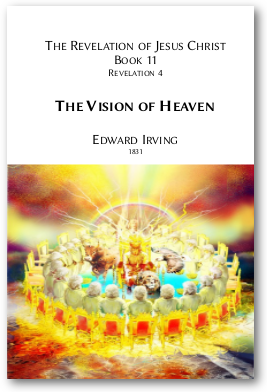 A door is opened into the heavenly places in Revelation 4, and we are given thereby a glimpse into the throne room of Heaven.
A door is opened into the heavenly places in Revelation 4, and we are given thereby a glimpse into the throne room of Heaven.
In this eleventh volume of the series on the book of Revelation, Irving expounds the various symbols in the first seven verses of Revelation 4: Christ in His glorified state, sitting upon the throne; the 24 elders circling the throne, and the 4 living creatures in the midst and round about the throne.
Not earthly rulers and armies, but the heavenly powers here displayed, all under the control of Christ, are what influences the direction of history, and the destiny of the earth and all the people in it. 137p
Contents
- Christ the Redeemer and King
- He Upon the Throne
- The Nazarite
- The Vision of Ezekiel
- The Rainbow
- Those Around the Throne
- The Twenty-Four Elders
- The Throne Itself
- Lightnings and Thunderings
- Voices
- Seven Lamps of Fire
- The Sea of Glass
- The Four Beasts, or Living Creatures
- Their Appearance
- The Fourfold Form
- Their Wings
- Full of Eyes
12. The Worship in Heaven
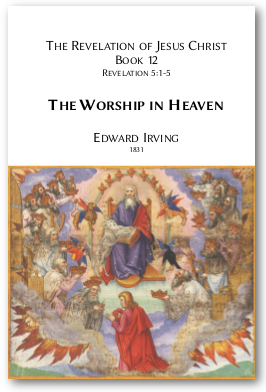 Continuing from where the last volume left off, this volume on the worship in heaven covers the last four verses of Revelation 4, and the first five verses of Revelation 5.
Continuing from where the last volume left off, this volume on the worship in heaven covers the last four verses of Revelation 4, and the first five verses of Revelation 5.
In the Christian life, worship is life, and life is worship. Worship is the recognition of God’s place in all things, the constant thankfulness the flows from an intelligent understanding and appreciation of His care, and a constant striving to work together in harmony with Him to complete the plan for the redemption of the earth. This is what is expressed in these verses that describe the heavenly worship.
In this vision, the seven-sealed book is also introduced, and the proclamation is made for someone to open the seals. What this sealed book is, how it relates to the work of redemption, and what kind of qualifications are needed to open it are fully expounded. 126p
Contents
- Introductory Remarks
- The Occupation of the Four Living Ones and Twenty-Four Elders
- Glory
- Honor
- Thanks
- Power
- Him Which Lives Forever
- Worship
- You Have Created All Things
- The Seven-Sealed Book
- A Book of Redemption
- A Sealed Book
- An Inheritance
- Rulership of the Earth
- Seven Seals
- Written Within and on the Backside
- In His Right Hand
- The Proclamation
- An Invitation
- A Strong Angel
- Proclaimed
- The Sealed Book
- Creation’s Inability to Redeem
- Heaven, Earth, Under the Earth
- The Seer’s Distress
- The Lion of the Tribe of Judah
- The Root of David
- The Name
- The Office and Action
- Conclusion
13. The Lamb Slain
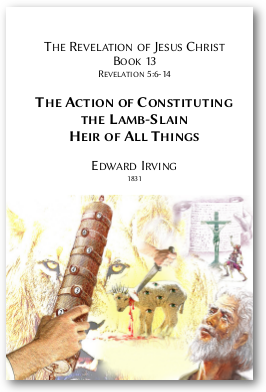 In this 13th Lecture, the rich symbolism of the glorious heavenly vision of Revelation 5 is beautifully unfolded.
In this 13th Lecture, the rich symbolism of the glorious heavenly vision of Revelation 5 is beautifully unfolded.
This book explains the following symbols, which God intends for us to study and grasp:
- The Seven-Sealed Book;
- The Titles of the Lamb: and what actions Christ had to perform to receive those Titles;
- The Identity, Song, and Actions of the Four Living Creatures and the Elders;
- The different elements in the Song of the Angels.
In the light of eternity, the news and happenings in this world, which occupy so much of men’s time and thoughts, are practically insignificant, compared to the importance of this heavenly vision. 122p
Contents
- Preliminary Remarks
- Old Testament Parallels
- Bringing into the Promised Land
- The Vineyard of Naboth
- Jeremiah’s Purchased Land
- A Mixture of Symbols
- Old Testament Parallels
- The Lamb
- The Lamb Slain
- The Paschal Lamb
- The Morning and Evening Sacrifice
- The Seven Horns and Seven Eyes of the Lamb
- The Title of the Lamb to Redeem
- The First Born
- Firstborn from Eternity
- Firstborn in the New Life
- Firstborn from the Grave
- The Mystery of God
- Perfect Obedience Required
- The Witnessing Parties
- The Absence of Satan
- Satan as the Usurper
- Lessons from the Redeemer’s Action
- Christ’s Dual Nature Before Creation
- Christ’s Oneness with Fallen Nature
- Christ’s Perfect Holiness as Man
- The First Born
- The Song of the Living Creatures and the Elders as Representatives of the Church
- The Harps
- The Incense
- The Vials
- The Song
- Redemption by His Blood
- Kindred, Tongue, People, and Nation
- Kings and Priests
- You are Worthy to Take the Book
- We Shall Reign on the Earth
- The Song of the Angels
- Power
- Riches
- Wisdom
- Strength
- Honor
- Glory
- Blessing
14. Opening of the First Four Seals
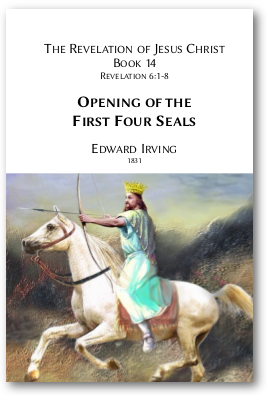 This volume covers the first four seals of Revelation 6.
This volume covers the first four seals of Revelation 6.
Irving’s interpretation differs slightly from what has since been considered standard Adventist historical interpretation. He sees these seals as being fulfilled in the actions of certain Roman emperors, starting with Constantine the Great, which resulted in the breakdown of the old Pagan Roman system, which had persecuted Christians so severely.
While the historical events he mentions are important, and his telling of them is accurate, I feel that there is a slight error here, in confusing these seals with judgments. It is the seven trumpets which bring judgments, but the seals represent the slow but gradual progress of Christ’s inheritance of the earth, which is accomplished through His actions in His church on earth, which Irving himself expounded most clearly, and which he comes back to in the next lecture on the fifth seal.
Having mentioned this caveat, I still recommend this volume to all serious Bible students, as the historical details are highly significant in understanding the rise of the Papacy, or how the spirit of Satan was insinuated into the Christian institution.
One might wonder how the decay of Christianity into darkness, as traced by the first four seals, could help to establish Christ’s dominion over the earth? The answer is given in the next seal, the “voice of the martyrs”. It is not through the oppressive powers and ruling classes that Christ’s victory is gained, but through His suffering servants, those who go through these severe temptations yet remain faithful. These are the ones who have gained the right to inherit and rule the earth with Christ. “The meek shall inherit the earth.” Matthew 5:5. 115p
Contents
- Introduction
- The Cause of the First Four Seals
- The First Pagan Persecution
- The Second Pagan Persecution
- The Third and Fourth Pagan Persecutions
- The Fifth Pagan Persecution
- The Sixth Pagan Persecution
- The Seventh Pagan Persecution
- The Eighth Pagan Persecution
- The Ninth and Tenth Pagan Persecutions
- The Opening of the First Seal
- A Conquering Man on a White Horse
- A Bow
- A Crown
- The Opening of the Second Seal
- A Red Horse
- Power to Take Peace from the Earth
- A Great Sword
- The Opening of the Third Seal
- A Black Horse
- A Yoke
- Famine
- The Opening of the Fourth Seal
- The Fourth Part of the Earth
- Death Upon a Pale Horse
- The Beasts of the Earth
- The Cherubim and the Seals
- Summary
15. Opening of the Fifth Seal
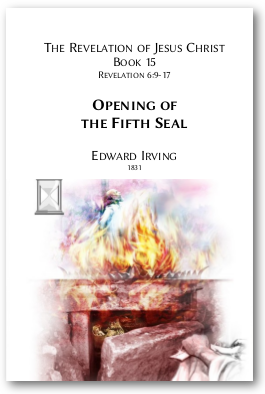 Finally, here is the last volume in Edward Irving’s lectures on the book of Revelation, covering the fifth seal, or the voice of the martyrs crying out for justice.
Finally, here is the last volume in Edward Irving’s lectures on the book of Revelation, covering the fifth seal, or the voice of the martyrs crying out for justice.
Linking the cry of the martyrs with the persecuting “little horn” power of Daniel 7 and 8, Irving finds historical fulfillment of this seal in the rise of the Papal power, her alliance with the kings of Western Europe (the ten horns), and the many persecutions that took place, especially during the Dark Ages and the Reformation period that followed. Historically, this may be the most accurate of Irving’s lectures in this series. 125p
He concludes with a warning that sounds down to our time:
Rome and the Roman Catholic apostasy shall fall with a hideous ruin, whereof the world has no example since the world began. And seeing that the face and front of their offending consists in the resistance and blasphemy of the Holy Ghost, let us Protestants beware of the same guilt.
Contents
- Introduction
- The Fifth Seal
- Under the Altar
- The Cry of the Martyrs
- How Long?
- O Lord, Holy and True
- The Apocalypse in Psalms
- White Robes
- Their Rest
- For a Little Season
- Their Fellowservants
- The Ten Horns
- A. Grow Out Of the Roman Kingdom
- B. Must Be Crowned Kings
- C. Obedient to the Little Horn
- D. Exist Until the End
- Naming the Horns
- The Little Horn
- Head of Church and State
- Appropriating the Name of God
- Wearing Out the Saints
- Changing Times and Laws
- The Time Period
- Summary
- The Martyrs
- Sonnets of Christ the Redeemer and King
